A Visit to Den
Hartogh Ford Museum
By John Emmering
Imagine appearing on a television game show and choosing the category “Ford
Automobiles.” The first question
posed is “Which city is the home of the world’s largest private collection of
Ford Automobiles?” Would you answer Reno, Nevada?
Dearborn, Michigan? Auburn,
Indiana? According to the Guinness book of World Records your answer would be
incorrect unless it was Hillegom, Netherlands.

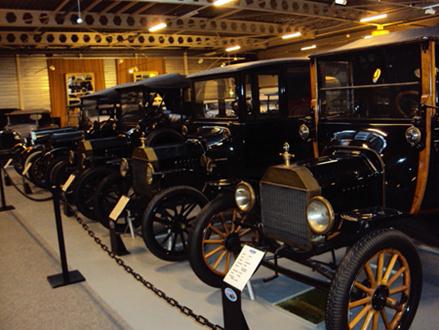
Yes, this little city of 20,000, located 20 miles southwest of Amsterdam, is the
home of den Hartogh Ford Museum, a
collection of approximately 200 Ford automobiles ranging from a reproduction of
Henry Ford’s 1896 Quadricycle to models of the 1948 Ford.
While it was difficult to acquire a lot of information about the
collection, I learned that it was started by Piet den Hartogh, founder of Den
Hartogh Logistics Company. This
large company is involved in many aspects of the petroleum industry such as
transportation of gasoline, as was required by the newly motorized public in the
early 20th century. Mr. den Hartogh
had a penchant for Ford automobiles and trucks, using them exclusively in his
business.
As time went on Mr. den Hartogh retained some of his old Ford vehicles and formed a small private collection. As the collection grew, people, including his wife, began to suggest that he make a museum out of the collection. So Piet den Hartogh did what any Ford enthusiast would do if he had unlimited assets to pursue his hobby, he found a nice location and began to acquire the large collection of vintage Fords from around the world that now comprise the den Hartogh Ford Museum. The museum was started sometime after the Second World War and today is a great, if not widely known, attraction.
In fall of 2010 my wife Robin and I planned a two week vacation to Europe, where
I had lived for about fifteen years both during military service and as a
Department of Defense Contractor.
After planning trips to castles and a Rhine Cruise, I as a Ford V-8 fanatic,
looked for some Ford related attractions.
I thought there might be something of interest at Ford Headquarters in
Cologne, Germany, but the attraction that stood out was Den Hartogh Ford Museum
in Holland.
After a couple enjoyable days in Germany we headed northwest in our Hyundai
rental car for a quick trip to Holland.
As we hit the Dutch border at Venlo we were greeted by very slow bumper
to bumper traffic. I asked a gas
station attendant the best way to Amsterdam and he pointed out a route that
might be faster than the obvious one, but cautioned that traffic would be bad.
With the encouraging comment from Robin “this is going to take us
forever” we moved along slowly through traffic.
As we neared Arnhem, I shifted the Hyundai into fifth gear and knew after
releasing the clutch that the clutch was no more.
I waited a few minutes to tell Robin that once we stopped we were stopped
for good. Anyway we pulled into a
gas station and phoned the rental company who sent a nice technician out. The
technician from the Dutch motor club was able to repair the problem.
We had lost several hours though so we continued on until we could find a
hotel. The next morning we headed to
Hillegom, through more heavy traffic, arriving about noon.
Visitors to the den Hartogh Ford Museum are greeted by a Model “T” sedan set up
on a high pole over the museum sign and it was exciting to reach our
destination. After paying our
entrance fee we entered into a Ford enthusiast’s wonderland.
A cutout photo of Henry Ford in front of a model of his Quadricycle
greeted us, and then a lineup of very early and very rare Ford products.
The line begins with a red 1903 Model “A” and moves through the Models
“B”, “C”, “F”, “K”, “R”, “S”, and “N”, produced during the first decade of the
20th century. These models are
rarely seen and unfamiliar to most of us.

The “Tin Lizzy” or Model “T” starting with the 1908 Model is featured in a large
collection. One can observe the
brass radiators and acetylene lamps of the early models.
A good number of Model “A”s are displayed marked as 1927-1931 models which may
reflect how they were designated in Europe, while we designate the first Model
“A” as a 1928 model. A nice line of
beautifully restored Model “A”s is on display and of course all body styles are
represented.
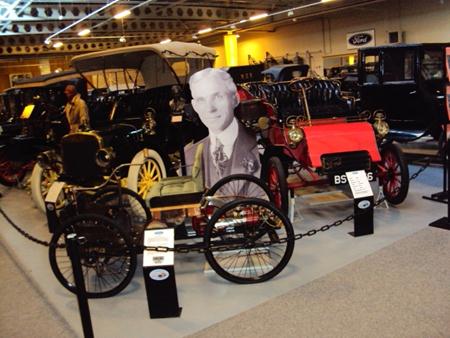
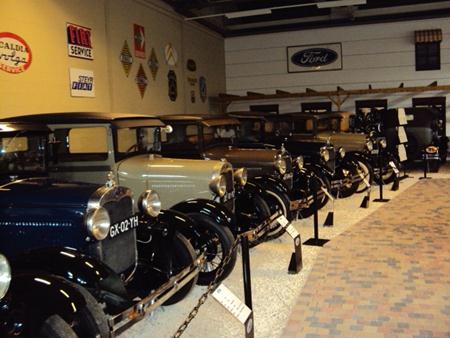
While the Model “A” was sometimes called a baby Lincoln, the full size Lincolns
Ford began to produce in 1922, after acquiring the Lincoln line, are also on
display. There are some really nice
early 20’s touring and closed cars, beautiful early thirties long Lincolns and
some Lincoln Zephyrs. Lincolns from
1922-1948 are well represented.
Of course the piece de resistance of the collection in my mind was the
collection of 1932-48 Ford V-8’s. All the vehicles look to be beautifully
restored 100 point cars. As the owner of a 1949 and a 1951 Ford, I wished the
collection went to 1953, but the museum reflects the vehicles designed and
produced during the lifetime of Henry Ford I.
The V-8 collection features a Model “B” and then a nice black V-8
roadster with its hood open exposing the flathead engine underneath.
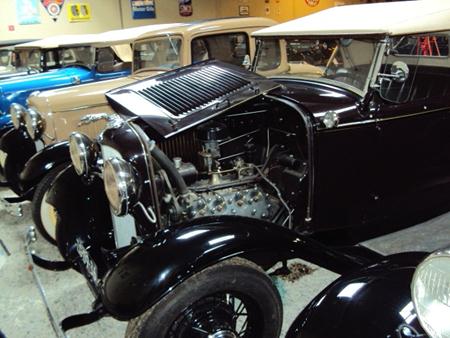
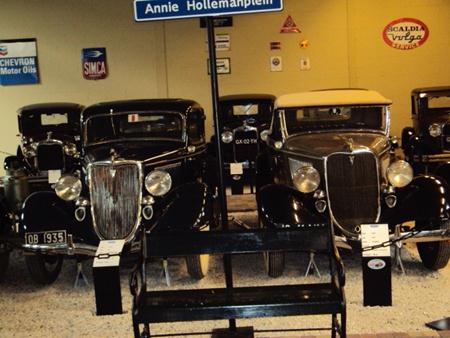 The
collection moves to a nice tan 1932 coupe and an attractive blue phaeton.
Some unique European type 1932 Fords also displayed.
Moving on I spied a 1933 roadster and 1934 sedan side by side, allowing a
comparison of the minor differences in those two car’s grills.
The
collection moves to a nice tan 1932 coupe and an attractive blue phaeton.
Some unique European type 1932 Fords also displayed.
Moving on I spied a 1933 roadster and 1934 sedan side by side, allowing a
comparison of the minor differences in those two car’s grills.
Viewing the collection I gazed on a maroon 1934 roadster, a tan 1934 station
wagon and then a trio of 1935 Fords featuring a double windshield touring car, a
sedan and a bronze roadster.
Three shiny 1936 Fords were also grouped together with a Washington Blue
humpback fordor sedan in the middle.
The 1937’s on display start with a gray fordor convertible next to a blue
cabriolet with a brown station wagon also thrown in.
Another row of cars begins with a lineup of 1938 through 1940 deluxe
models next to their standard counterparts.
I lingered over a black 1938 standard sedan I remembered from a
photograph as the type of car my grandfather drove until 1949.
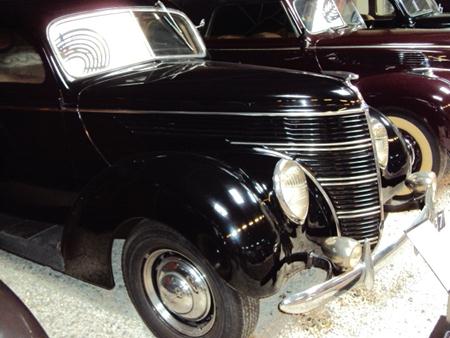
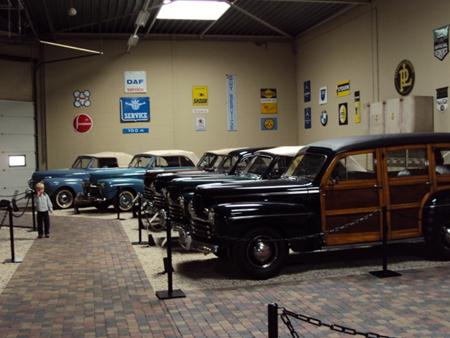
The batteries in my camera went dead and Robin ran to the car to charge them up
while I walked through the collection again by myself surveying the large
assemblage of trucks from Model “T” days through the 1948 models and the many
buses and specialty vehicles. My
home town of Chicago was represented by a Model “AA” flatbed “Al Capone” Beer
Wagon, with his name emblazed on the doors.
There is a display showing an old mechanic’s shop and the walls are
covered with old Ford logos and paraphernalia.
The old time ambiance consisting of simulated cobblestone pavement,
street lamps and gas pumps provide a nice setting for the old Fords.
With my camera batteries recharged I photographed the last line of the V-8
collection which began with light blue 1941 and 1942 convertibles, and continues
with a maroon 1947 and green 1946 convertible.
The fine collection of Ford V-8’s ends with a pristine 1946 Navy Blue
Station Wagon which would be the envy of any V-8 enthusiast.
Our visit to den Hartogh Ford Museum was a memorable one giving me a new
appreciation for the fine cars Ford produced and why I’ve made them my hobby.
Should you find yourself near Amsterdam it would be a great investment of
half a day to see the museum, otherwise you can get a great virtual tour on the
internet at the museum’s website and through photos posted elsewhere on the web
by those that have paid a visit. I’m
glad we took time to visit den Hartogh and I enjoy sharing the experience with
my fellow V-8ers.